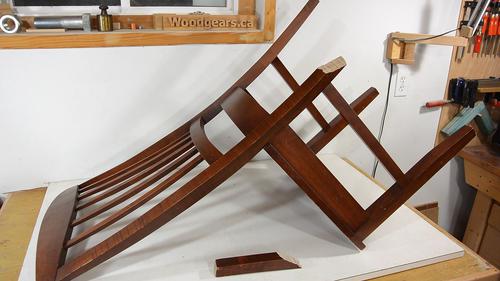 My friend Rick has a set of nice maple dining room chairs. The leg broke off
one of these in the process of moving, so he asked me to have a look.
My friend Rick has a set of nice maple dining room chairs. The leg broke off
one of these in the process of moving, so he asked me to have a look.
 My friend Rick has a set of nice maple dining room chairs. The leg broke off
one of these in the process of moving, so he asked me to have a look.
My friend Rick has a set of nice maple dining room chairs. The leg broke off
one of these in the process of moving, so he asked me to have a look.
The chairs originally cost around $400 each. So it's definitely worth fixing.
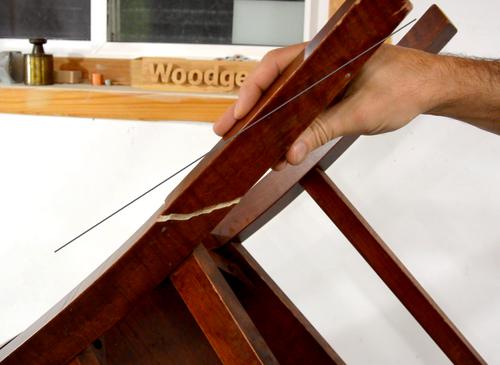 The reason the chair leg broke was that the grain was a bit crooked. The line
on the picture at left shows the direction of the original boards, as can be seen
by a faint glue line just above the line on the picture. With the curly grain on
this piece, the grain direction deviated quite a bit from the board direction,
and with the leg at an angle from the board direction, the grain was at quite
an angle compared to the leg.
The reason the chair leg broke was that the grain was a bit crooked. The line
on the picture at left shows the direction of the original boards, as can be seen
by a faint glue line just above the line on the picture. With the curly grain on
this piece, the grain direction deviated quite a bit from the board direction,
and with the leg at an angle from the board direction, the grain was at quite
an angle compared to the leg.
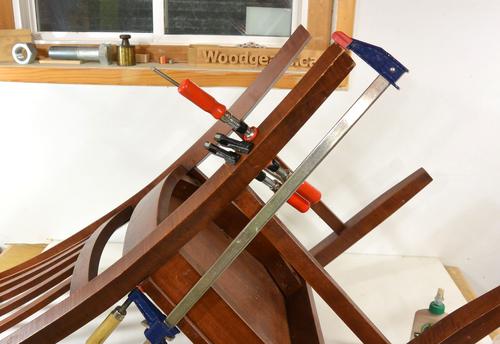 Thanks to the curly grain in this piece, lining up and gluing the pieces was easy.
And with the glue as strong as the wood, just gluing it on makes it good as new.
But with the grain crooked as it is, good as new really isn't very good.
Thanks to the curly grain in this piece, lining up and gluing the pieces was easy.
And with the glue as strong as the wood, just gluing it on makes it good as new.
But with the grain crooked as it is, good as new really isn't very good.
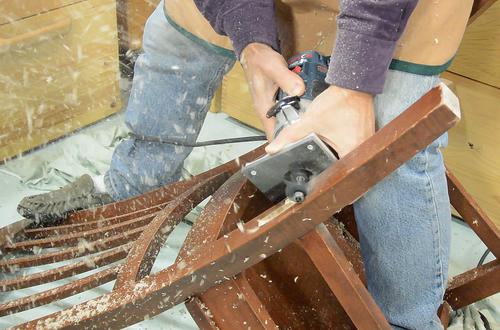
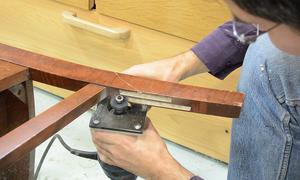 So I cut some channels into the legs to inlay some wood
with the grain parallel to the leg. I used a slot cutting
bit on a palm-sized router. A router with a bigger base would have been better
for some of these cuts, but the base would have prevented me from getting close
enough in a few spots.
So I cut some channels into the legs to inlay some wood
with the grain parallel to the leg. I used a slot cutting
bit on a palm-sized router. A router with a bigger base would have been better
for some of these cuts, but the base would have prevented me from getting close
enough in a few spots.
I hate using a router like that. Sawdust thrown straight at me. Ugh!
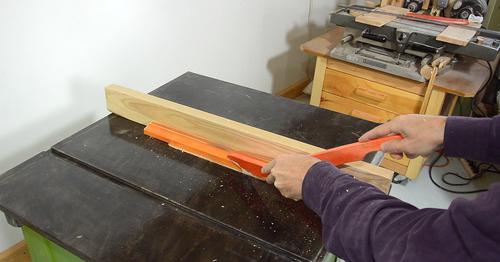
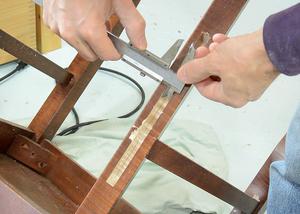 I then measured the width of the slot and cut some hard maple of just
the right width. I'm using a piece of recycled, and stained maple,
that's why it looks so red.
I then measured the width of the slot and cut some hard maple of just
the right width. I'm using a piece of recycled, and stained maple,
that's why it looks so red.
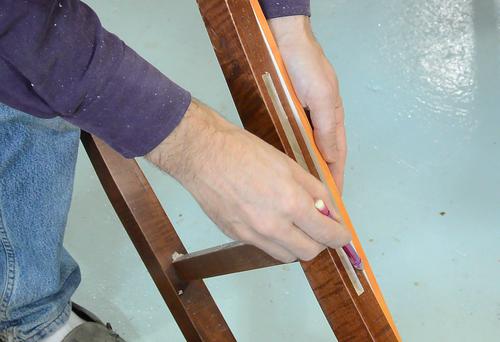
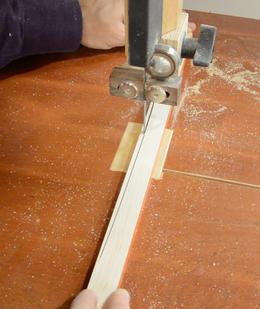 With the inlay having to follow a curve, I start by marking the curve off
the leg onto my workpiece, then cut to the line on the bandsaw.
With the inlay having to follow a curve, I start by marking the curve off
the leg onto my workpiece, then cut to the line on the bandsaw.
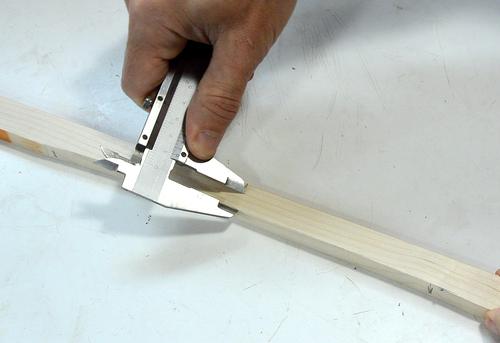
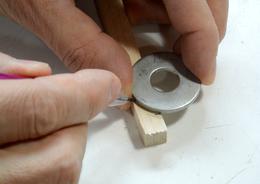 I then measured the depth of the groove, added half a millimeter, and
scored a line at the right distance parallel
to the curve, and then cut to the line. This gives me the inside
curve. For the ends, I used a 1 1/4" (30 mm) washer (same diameter as my router bit)
to mark a radius, which I then also cut on the bandsaw.
I then measured the depth of the groove, added half a millimeter, and
scored a line at the right distance parallel
to the curve, and then cut to the line. This gives me the inside
curve. For the ends, I used a 1 1/4" (30 mm) washer (same diameter as my router bit)
to mark a radius, which I then also cut on the bandsaw.
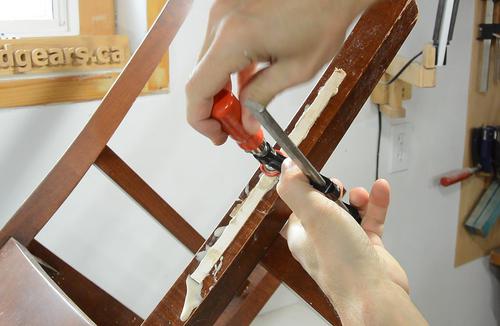 gluing the inlay, using an excessive amount of glue, just to make sure I had all
the gaps filled.
gluing the inlay, using an excessive amount of glue, just to make sure I had all
the gaps filled.
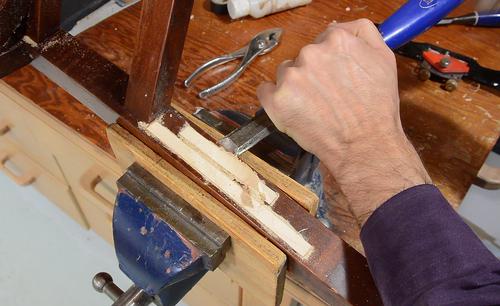 After letting the glue dry for a few hours, I clamped the chair in a vise and
started chiseling the inlays level with the chair leg.
After letting the glue dry for a few hours, I clamped the chair in a vise and
started chiseling the inlays level with the chair leg.
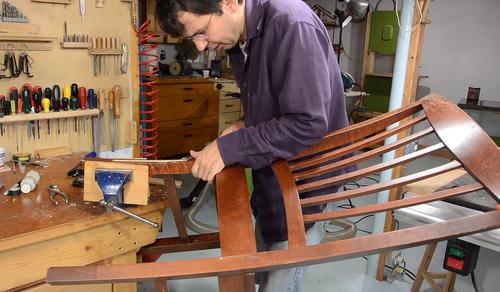
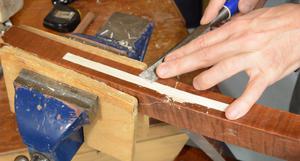 I clamped the chair's leg in my vise. Hmm, if I clamp a leg in a vise, does that make
it a leg vise? I can however say that a swiveling metal vise like this one is
much handier for this application than a traditional workbench leg vise would be!
I clamped the chair's leg in my vise. Hmm, if I clamp a leg in a vise, does that make
it a leg vise? I can however say that a swiveling metal vise like this one is
much handier for this application than a traditional workbench leg vise would be!
With careful work, it's possible to flush trim the wood with a chisel without damaging the surrounding finish — except the spot (near my ring finger) where I slipped with the router and gouged the wood.
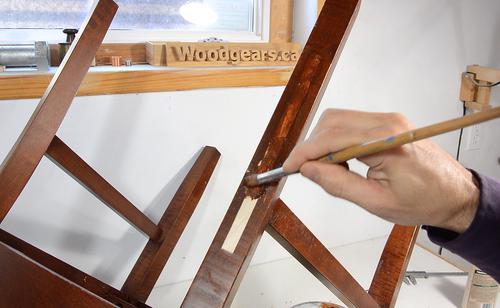
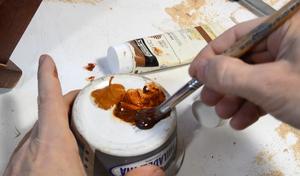 Having some acrylic artist paints sure comes handy for repairs like this, having
the paint in convenient tubes and being able to match the colour.
Having some acrylic artist paints sure comes handy for repairs like this, having
the paint in convenient tubes and being able to match the colour.
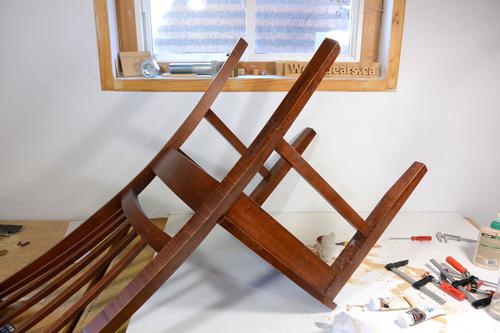 Finished repair. You can definitely tell there was a repair done to this leg,
but it doesn't catch your eye unless you look for it.
Finished repair. You can definitely tell there was a repair done to this leg,
but it doesn't catch your eye unless you look for it.
Furniture repair isn't that fun or creative, but it's one of the most effective things, in terms of saving money, that you can do in a small home workshop.